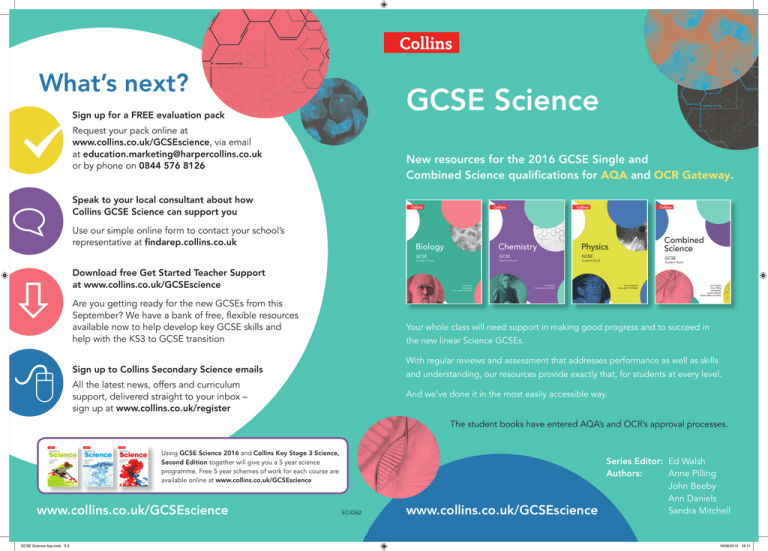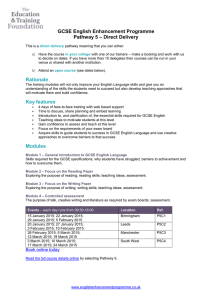GCSE Science
advertisement

What’s next? GCSE Science Sign up for a FREE evaluation pack . Request your pack online at www.collins.co.uk/GCSEscience, via email at education.marketing@harpercollins.co.uk or by phone on 0844 576 8126 New resources for the 2016 GCSE Single and Combined Science qualifications for AQA and OCR Gateway. Speak to your local consultant about how Collins GCSE Science can support you Use our simple online form to contact your school’s representative at findarep.collins.co.uk ò 8 Download free Get Started Teacher Support at www.collins.co.uk/GCSEscience Are you getting ready for the new GCSEs from this September? We have a bank of free, flexible resources available now to help develop key GCSE skills and help with the KS3 to GCSE transition Sign up to Collins Secondary Science emails All the latest news, offers and curriculum support, delivered straight to your inbox – sign up at www.collins.co.uk/register Your whole class will need support in making good progress and to succeed in the new linear Science GCSEs. With regular reviews and assessment that addresses performance as well as skills and understanding, our resources provide exactly that, for students at every level. And we’ve done it in the most easily accessible way. The student books have entered AQA’s and OCR’s approval processes. Using GCSE Science 2016 and Collins Key Stage 3 Science, Second Edition together will give you a 5 year science programme. Free 5 year schemes of work for each course are available online at www.collins.co.uk/GCSEscience www.collins.co.uk/GCSEscience GCSE Science 4pp.indd 2-3 SCI082 www.collins.co.uk/GCSEscience Series Editor: Ed Walsh Authors: Anne Pilling John Beeby Ann Daniels Sandra Mitchell 19/08/2015 16:11 GCSE Science for AQA and OCR Gateway GCSE Science is changing, and the new edition of GCSE Science from Collins has been completely revised and updated to develop and embed the skills your students need to succeed in all three assessment objectives, while providing a clear and supportive route through the new, more challenging GCSE content. Key changes to the GCSE Science specification: • Practical assessment is changing: controlled assessment is being discontinued and 15% of the assessment will now be allocated to practical skills • New, more challenging content has been introduced at both tiers • There is an increased maths element, Maths will account for 10–30% (1:2:3 Biology, Chemistry, Physics) of assessment marks for separate science and 20% for combined science (1:2:3 Biology, Chemistry, Physics) How is Collins GCSE Science structured? Teach Teacher Packs Deliver the new GCSE Science specifications with confidence using a detailed introduction to the new specification, plans for co-teaching the different courses, 2, 3 and 5 year schemes of work, and a comprehensive set of editable lesson plans and worksheets. Assess Ensure all students make good progress in GCSE Science with our brand new, innovative assessment framework that uses regular checkpoints to track students’ progress across the linear course. Collins Connec Content is available online at home and at school, meaning it’s ideal for use as a front-of-class teaching tool and as a way to set homework and tests. GCSE Science 2016 Build Skills GCSE Transition Resources Develop students’ skills in key areas so that they can tackle the new specifications with greater confidence and build towards success. Chapter 6: Waves and Energy Transfer Chapter 3: Obtaining Useful Materials 6.8 Applying key ideas • New assessment objectives Worksheet 3.3.14 Exploring natural polymers Rainbows Learn Objectives Extract ideas from the text about light and its properties. Use information about reflection and refraction to explain the formation of rainbows. Apply the ideas to explain the way CDs and DVDs can produce coloured light. How our resources will support you and your students: • Featuring one Practical in every chapter we develop and test skills in analysing, interpreting and evaluating information and ideas so they are fully prepared for the indirect assessment > Complete the following sentences. Use the words in the box; you may use a word more than once. Polymers are ………………………… molecules. They are made up from ………………………… ………………………… of small repeating units, each called a ………………………… . Chemical reactions occur to make the molecules bond together. Sometimes ………………………… , The purpose of this activity is to provide an opportunity to see how successfully students are grasping the key ideas so far. It is not designed to be used as a formal test – it might be that the students work on the questions collectively. It does provide an opportunity for you to look at written work, engage students in discussions and form ideas about progress being made. natural polymers are found in our bodies. These include ………………………… and The tasks are progressive. Lower-attaining students should be able to tackle the first two or three tasks and higher-attaining students will find the later tasks more challenging. Teaching and learning Student Books Fully revised and updated by a team of expert authors for the new GCSE Single and Combined Science specifications for AQA and OCR Gateway, the student books combine clear and comprehensive explanations with a wealth of practice opportunities, and help build the skills students need to succeed. page 1/2 1 What are polymers? Outcome Clear and effective responses to questions, indicating understanding and the next steps in learning. Engage Challenge the students to reflect back over the last few lessons and identify some of the key ideas they have learned about and investigated. Draw out some responses about these ideas, and explain that it is important that, as learners, they develop a sense of their own progress. You may wish to repeat (it may have been shown in previous lesson) a demonstration of the formation of a ‘rainbow’ from a spray of water on a sunny day. Ask the students, working individually, to read the text about rainbows in the Student Book. Point out the photograph of the double rainbow (Figure 3.6.8b) and encourage the students to look for similarities and differences between the inner and outer bows. Challenge and develop Ask the students, working individually, to complete the first two tasks in the Student Book. Depending on their ability to interpret scientific diagrams, you may need to adopt strategies such as: asking the students to redraw the diagram, explaining what each line they draw represents working with a group of students who have difficulty verbalising what the diagram shows allowing the students to work in pairs to share ideas and interpret the diagram. Explain Ask the students to attempt tasks 3 and 4 in the Student Book, either individually or collaboratively. Again, depending on their ability to work with and interpret scientific diagrams you may need to adopt the strategies listed above. Consolidate and apply Ask the students to present their responses to the various tasks, either orally or by displaying their work. Extend Ask students able to progress further to attempt task 5 in the Student Book. It is a challenging task, and even those who have progressed quickly and correctly may need some guidance. ………………………… and/or a ………………………… are used to help the reactions occur. Many ………………………… . Other natural polymers are found in plants. These include …………………………, ………………………… and ………………………… . cotton DNA pressure big protein monomer cellulose long chains heat starch catalyst 2 Properties of natural polymers >> Use the cards on page 2 of this worksheet to match up properties of polymers to their uses. Write the matching pairs here. ............................................................................................................................................................ 3 Evaluating experimental design >>> Read the following method for an investigation that a student is carrying out. Suggest how the student might improve her investigation. The aim is to investigate how elastic different polymers are. The student investigates cotton, strips of wood, and silk. She takes a measured length of cotton, attaches one end to a newtonmeter, and fixes the other end. She then determines the maximum force that can be applied to stretch the cotton before it breaks. Then she repeats the experiment with another material. ............................................................................................................................................................ ............................................................................................................................................................ ............................................................................................................................................................ ............................................................................................................................................................ ............................................................................................................................................................ ............................................................................................................................................................ ............................................................................................................................................................ ............................................................................................................................................................ ............................................................................................................................................................ ............................................................................................................................................................ Key Stage 3 Science Teacher Pack 3 Key Stage 3 Science Teacher Pack 3 182 © HarperCollinsPublishers Limited 2014 © HarperCollinsPublishers Limited 2014 • Maths skills at the appropriate level are embedded throughout the content and in frequent questions, providing a wealth of practice in applying maths to the science • Opportunities to ‘think like a scientist’ within real-world contexts encourage students to challenge ideas, analyse and evaluate, giving them the confidence to fulfil the requirements of AO3 • Fully flexible support – our course structure allows you to teach your way. With 2, 3 and 5 year schemes of work allowing easy progression from KS3 and a strong basis for A level, options for teaching foundation and higher, single sciences and combined GCSE Science 4pp.indd 4-5 Collins resources for GCSE Science are available for both the AQA and OCR Gateway 2016 specifications, and will cover Higher and Foundation tiers for both specifications. 19/08/2015 16:11





